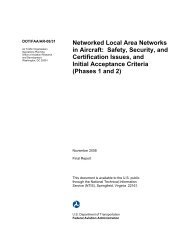Published Report (DOT/FAA/CT-94-36)
Published Report (DOT/FAA/CT-94-36)
Published Report (DOT/FAA/CT-94-36)
You also want an ePaper? Increase the reach of your titles
YUMPU automatically turns print PDFs into web optimized ePapers that Google loves.
Technical Observers <strong>Report</strong><br />
This report is the consensus of the Technical Observers concerning<br />
the DIA triple simultaneous approach simulation. It contains<br />
general conclusions concerning the conduct of the simulation, as<br />
well as our recommendations to the Technical Work Group.<br />
The simulation was to triple runways spaced 7,600 feet and 5,280<br />
feet apart with a simulated radar system including a 4.8 second<br />
update rate and the Final Monitor Aid (FMA). FMA is the Sony 20 x<br />
20 high resolution color display with controller alerts.<br />
During the simulation, the controllers had little difficulty<br />
detecting and resolving blunders. The relative ease in which the<br />
controllers were able to maintain required Separation became more<br />
evident as they grew accustomed to the equipment and procedures.<br />
In fact, as controllers gained experienced with the FMA, they were<br />
able to wait longer to evaluate the situation and then initiate<br />
action to resolve the blunder. Alert algorithms and runway Spacings<br />
appeared to be the factors which allowed the controllers to take<br />
extra time when evaluating these situations. The slower response<br />
time did not appear to cause any "close calls" or test criterion<br />
violations (TCV). As the simulation progressed, it appeared that<br />
some controllers grew bored as they monitored approaches. Although<br />
the time spent on position monitoring simultaneous approaches<br />
varies facility to facility, controllers would never be required<br />
to perform this function for such long periods in reality. The ease<br />
in which blunders can be detected with the equipment tested and the<br />
monotony of the task, are factors which may possibly influence a<br />
controllers ability to maintain separation between aircraft.<br />
Whether a controller is bored or not is of course impossible to<br />
observe, however the Technical Observers agree this area may need<br />
some additional study through human factors testing.<br />
All but two controllers who participated had prior experience in<br />
the procedures and equipment used for this test. Early in the<br />
simulation the experience level of the new controllers was evident.<br />
Even though a briefing was conducted to all personnel and practice<br />
runs were performed prior to the actual simulation, the Technical<br />
Observers believe that more time should be devoted to training of<br />
controllers new to these simulations. The practice runs were<br />
conducted until the new controllers indicated they felt comfortable<br />
with equipment and procedures. The Technical Observers believe the<br />
training should be conducted for a predetermined period decided by<br />
the TWG and not left up to the discretion of the new controllers.<br />
This training could effect the early portion of the simulation. As<br />
an example, there were several nuisance breakouts during the early<br />
portion of the simulation due to the new and returning controllers<br />
adjusting to the equipment.<br />
I- 1

















